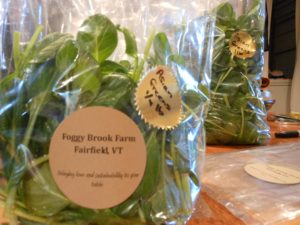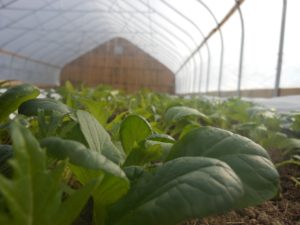Switch the Boots, Wash the Hands, and Keep Farm Records
Food safety planning tips from Vermont for new farmers and a refresher for all
Water supply, soil quality, harvesting procedures, and adding livestock are early stage considerations in developing a small farm. Often some of the most appealing in agricultural planning due to the concrete nature of their applications can cause food contamination and other health hazards when met with the lack of incorporating food safety into these and other areas of farming – even at a small scale.

Food contamination can happen when disease producing pathogens spread from people, animals, and insects. Bacteria found in raw food can contaminate cooked foods and other surfaces and can remain active if not cooked or prepared properly. Storage temperature, water, soil, and materials can also be causes for contaminating food.
Learn More and Connect
Christine Kubacz, a new farmer/owner of Foggy Brook Farm in Fairfield, Vermont found the abundance of information regarding food safety to be overwhelming at first. “Take your time with decisions, work with a mentor, ask questions, and do your research,” she advises other new farmers. “Be prepared to make mistakes and that is part of learning. I found having the support of other farmers and working with a larger, more experienced farm to be crucial. Rolling with what Mother Nature hands us is a humbling experience.
Foggy Brook Farm grows greens through an extended growing season, raises eggs, and supports a growing assortment of value-added products for market-direct sales. Kubacz found the logistics around washing produce and solely preparing one value-added product at a time to be first areas of research and learning to implement on her farm.

Bagged greens from Foggy Brook Farm are sold at the local farmers’ market, at area stores and restaurants, and at the farmstand
“I also didn’t think about all of the different reasoning behind proper labeling – for safety, allergies, tracking and being able to think about the whole picture – from farm to plate in essence – has allowed me to understand how to implement,” shares Kubacz.
Like many new farmers, the to-do list requirements and reality of finances tug on the purse strings and can be inhibiting to growth. “Learning I needed different boots for the greenhouse from the chicken coop – now that was a quick fix!”
State Extension offices like those at the University of Vermont, provide the resources, details, and support as well as training and practical education for farmers at many stages. Online resources like those on food safety are available for download and are some of the materials farmers like Christine Kubacz can use to conduct research as a new farmer. Staying current with food safety procedures is also important, as changes are made as new research and laws come into effect.

An assortment of spicy greens are Foggy Brook Farm’s specialty, grown in their greenhouse in Fairfield, Vermont
The Food Safety Modernization Act (FSMA) is a federal food safety law that currently has two sets of proposed rules that authorize new regulations for produce production and food safety measures for facilities that process food for human consumption.
“FSMA grants the Food and Drug Administration (FDA) broad new power to enforce food safety standards on farms. The draft proposed rules lacked flexibility and scale- and supply- appropriate regulations, and could negatively impact produce growers, farms that aggregate product with other farms, and farms that even minimally process what they produce,” comments Erica Campbell, program director of Vermont’s Farm to Plate Initiative. We are hoping that FDA’s final rules will be more flexible to small and medium sized farmers so it won’t financially overburden them.”
Key Food Safety Considerations, According to the UVM Practical Produce Safety Model:
- Conduct a risk assessment of your farm’s land history to identify potential sources of contamination.
- Take proper precautions when using manure and compost to avoid produce contamination. A four month rotation is suggested between raw manure or livestock and produce fields/harvest. If making your own compost, keep at 131 degrees for at least 3 days as well as turning. The FDA is considering revisions to this, so stay informed.
- Mitigate the potential for pathogens in your water supply by planning out the irrigation system, beginning with water quality testing, which should be done before the start of each season. Use drip irrigation if pulling from surface water to reduce potential for microbial contamination – especially on leafy greens.
- Plan for reducing potential field contamination such as wild animals, flooding, farm equipment spills, domestic animals and livestock.
- Develop policies for sick and injured workers as well as protocol for hygiene. Convenient hand washing stations are a must!
- Consider precautions when harvesting produce as activity can stir up pathogens. Implement good hygiene and cleaning produce practices which can improve quality and shelf life, as well as safety. Triple wash those greens!
- Keep storage surfaces and facilities clean, organized, and use proper temperatures for storage procedures.
- Label produce so it can be tracked backwards in cases of recalls and prepare invoices and harvest logs.
- If engaging in agritourism, or on-farm visits, additional precautions are needed to reduce pathogens spread between animals and humans.


